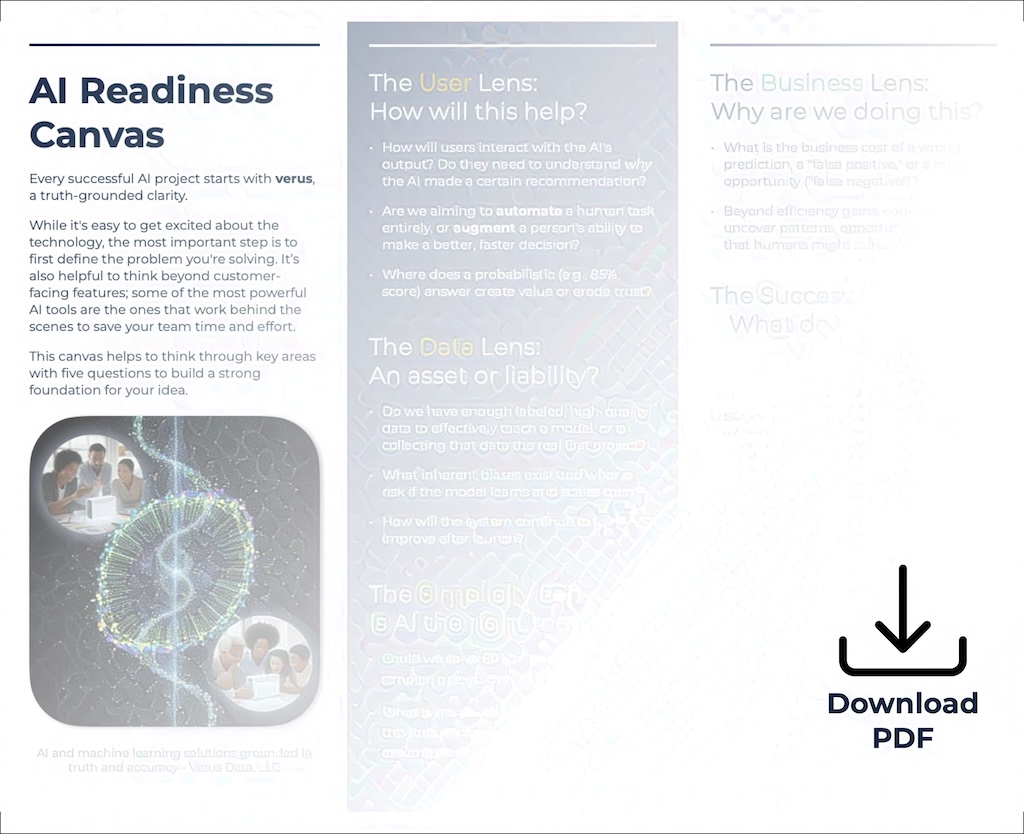The Readiness Signal
As the first Signal publication for Verus Digital, we’ll start with a quick retrospective and a practical takeaway you can use. Ten months of frontline experience have revealed a striking pattern: revolutionary technology alongside recurring implementation missteps.
Evolution Context
The past nine months have delivered a flash of high-speed changes in the use of ML and AI that have marked impacts on the space and just about every modern business. On one hand, we’ve witnessed technological leaps – models becoming more capable while prices plummet, partnerships reshaping competitive dynamics, and new heights in video and code generation. On the other hand, fundamental business adoption patterns remain remarkably static: organizations still rush toward AI solutions without proper groundwork, security vulnerabilities persist due to hasty implementations, and the gap between technological possibility and practical readiness continues to widen. This juxtaposition creates opportunity and significant risk for businesses navigating AI adoption decisions.
What’s Happening
Rapid Adoption
- Model Competition Intensifies: The model wars between the tech leaders have continued and prices have continued to drop, like OpenAI’s token costs at almost a 90% discount while Meta offered $100M compensation packages to top talent.
- Strategic Partnerships Reshape Market: Adobe’s integration with Google’s Gemini models show a significant pivot from copyright-centric models. Apple has indefinitely delayed its own AI efforts in favor of a multi-partner strategy. Simultaneously, OpenAI promises a $300B future for Oracle while McKinsey prices the market closer to $7T.
- Code Generation Reaches Maturity: Tools like Cursor and GitHub Copilot now handle complex development tasks, with some developers reporting 50-70% productivity gains. A new business practice saw the CEO of Windsurf go to Google and its staff to Cognition.
- Legal Precedents Favor AI Training: Recent federal court decisions, sided with fair use doctrine for Anthropic, given the unique capabilities of the trained technology. There are still more than 15 cases open according to the Authors Guild, but some precedents have been set.
- Government Investment Surges: The US government has reversed a decision limiting exports in exchange for 15% of NVIDIA and AMD revenues. Later it also removed restrictions from the CHIPs act with Intel for ~8.9B in stock.
- Multimodal Capabilities Breakthrough: Video generation quality from tools like Google Veo 3 and Runway Gen-3 are remarkable. Full Stop. Additional standardizations bring speed and editing with text to video capabilities that make the imaginative cat or introspective historical figure come to life in a single hour-long session.
Disclaimer: From a real photo, the family feline, Luna, gets a little more time outdoors. While not on any Oscar short-lists, composition required only about an hour from concept to download.
Remaining Persistent Challenges
- Capability is Not Responsibility: Individuals and smaller tech firms quickly buy into vibe coding as a staffing augment but often experience incomplete implementations with security holes and worse. Recent incidents include AI coding assistants introducing common SQL injection vulnerabilities and Replit’s agentic coding system entirely deleting an enterprise database.
- Challenging Returns and Skills Gaps: An MIT study found only 5% of early enterprise ventures have realized initial gains. Gartner predicted 30% of GenAI projects abandoned and 40% of agentic projects abandoned because of disconnects between the ability to adapt internal systems or silos. However, McKinsey offers hope that AI/ML skillsets and adoption were on the rise in early 2025.
- Implementation Without Strategy: Businesses are rushing to AI and ML solutions as a panacea, but often they don’t do the introspective front-work to define success metrics or understand true data readiness. OpenAI is adding enterprise consulting services (typically with 40-50% margins) to capitalize on this insecurity.
Why Implementation Matters
This pattern reveals a critical insight: technological advancement doesn’t automatically solve adoption challenges. While AI tools become more powerful and accessible, success still depends on fundamental business preparation – understanding user needs, data quality, process integration, and measurable outcomes.
Spinning positive, everyone is still excited and eager to experiment with AI automations and assistants — and we are too! We want to help individuals and businesses alike get a better start when they’re considering a potential commitment to a new AI project.
Looking Forward
The convergence of powerful, affordable AI tools with persistent implementation challenges creates a unique opportunity for prepared organizations.
So we created an AI Readiness Canvas — a literal brochure — focusing on five critical perspectives to use for your challenge: the user lens, the data lens, the simplicity lens, the business lens, and the success lens. Not all of these perspectives are equally important to everyone, but they should all be considered.
Companies that invest in readiness assessment before technology selection will be positioned to capitalize on continued model improvements and cost reductions. The window for thoughtful adoption is narrowing as competitive pressures mount, making strategic preparation increasingly valuable.
After you’ve taken a look at the readiness canvas if you’d like to talk with a domain expert without project commitments or scope documents — we welcome you to consider an advisory services session. The conversation format is meant to be fun but insightful and the advice comes from serious industry practitioners specific to your domain. Most importantly, you’re in control of the conversation so it can be introductory or eleventh-hour fix advice.
At times, the chasm is so profound it sometimes feels like trying to grow ‘Synaptic Petals’ – beautiful in concept, but elusive in their practical manifestation without the right conditions, a challenge researchers like Eric Zavesky explore in vastly different fields.
Want to see a signal every time we write? Click to subscribe below.

